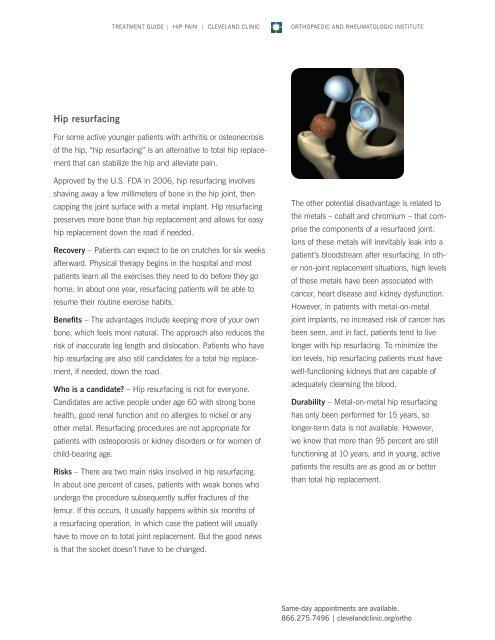Treatment Guide Hip Pain - Cleveland Clinic
Treatment Guide Hip Pain - Cleveland Clinic
Treatment Guide Hip Pain - Cleveland Clinic
Create successful ePaper yourself
Turn your PDF publications into a flip-book with our unique Google optimized e-Paper software.
<strong>Hip</strong> resurfacing<br />
For some active younger patients with arthritis or osteonecrosis<br />
of the hip, “hip resurfacing” is an alternative to total hip replace-<br />
ment that can stabilize the hip and alleviate pain.<br />
Approved by the U.S. FDA in 2006, hip resurfacing involves<br />
shaving away a few millimeters of bone in the hip joint, then<br />
capping the joint surface with a metal implant. <strong>Hip</strong> resurfacing<br />
preserves more bone than hip replacement and allows for easy<br />
hip replacement down the road if needed.<br />
Recovery – Patients can expect to be on crutches for six weeks<br />
afterward. Physical therapy begins in the hospital and most<br />
patients learn all the exercises they need to do before they go<br />
home. In about one year, resurfacing patients will be able to<br />
resume their routine exercise habits.<br />
Benefits – The advantages include keeping more of your own<br />
bone, which feels more natural. The approach also reduces the<br />
risk of inaccurate leg length and dislocation. Patients who have<br />
hip resurfacing are also still candidates for a total hip replace-<br />
ment, if needed, down the road.<br />
Who is a candidate? – <strong>Hip</strong> resurfacing is not for everyone.<br />
Candidates are active people under age 60 with strong bone<br />
health, good renal function and no allergies to nickel or any<br />
other metal. Resurfacing procedures are not appropriate for<br />
patients with osteoporosis or kidney disorders or for women of<br />
child-bearing age.<br />
TREATMENT GUIDE | HIP PAIN | CLEVELAND CLINIC<br />
Risks – There are two main risks involved in hip resurfacing.<br />
In about one percent of cases, patients with weak bones who<br />
undergo the procedure subsequently suffer fractures of the<br />
femur. If this occurs, it usually happens within six months of<br />
a resurfacing operation, in which case the patient will usually<br />
have to move on to total joint replacement. But the good news<br />
is that the socket doesn’t have to be changed.<br />
ORTHOPAEDIC AND RHEUMATOLOGIC INSTITUTE<br />
The other potential disadvantage is related to<br />
the metals – cobalt and chromium – that com-<br />
prise the components of a resurfaced joint.<br />
Ions of these metals will inevitably leak into a<br />
patient’s bloodstream after resurfacing. In oth-<br />
er non-joint replacement situations, high levels<br />
of these metals have been associated with<br />
cancer, heart disease and kidney dysfunction.<br />
However, in patients with metal-on-metal<br />
joint implants, no increased risk of cancer has<br />
been seen, and in fact, patients tend to live<br />
longer with hip resurfacing. To minimize the<br />
ion levels, hip resurfacing patients must have<br />
well-functioning kidneys that are capable of<br />
adequately cleansing the blood.<br />
Durability – Metal-on-metal hip resurfacing<br />
has only been performed for 15 years, so<br />
longer-term data is not available. However,<br />
we know that more than 95 percent are still<br />
functioning at 10 years, and in young, active<br />
patients the results are as good as or better<br />
than total hip replacement.<br />
Same-day appointments are available.<br />
866.275.7496 | clevelandclinic.org/ortho

















